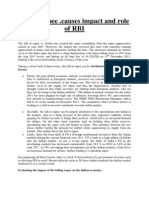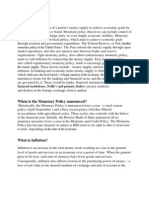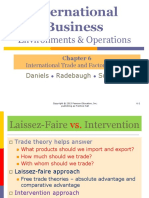RBI Intervention
RBI Intervention
Uploaded by
Javed ShaikhCopyright:
Available Formats
RBI Intervention
RBI Intervention
Uploaded by
Javed ShaikhOriginal Title
Copyright
Available Formats
Share this document
Did you find this document useful?
Is this content inappropriate?
Copyright:
Available Formats
RBI Intervention
RBI Intervention
Uploaded by
Javed ShaikhCopyright:
Available Formats
RBI Intervention
In the wake of the rupees slide, there has been much talk about the RBIs intervention in the currency markets to support the Indian currency, including a massive selloff of dollars. But what exactly is RBI intervention, how does it work and what impact can it have? Heres a quick guide to understanding what tools the RBI has at its disposal and what it can do.
Fall of the rupee: The rupee on Wednesday closed at an all-time low of 54.49 to the dollar. It has recovered on Thursday but was still at 54.23 against the dollar. The local currency first slumped to an all-time low of 54.46 against the dollar in afternoon trade even as the Reserve Bank of India broke its silence over the falling rupee, saying it would do its "best possible to curb volatility".
Direct Intervention: In case of any currency movement, a countrys central bank can directly intervene to either push the currency up, as India has been doing, or to keep it artificially low, as the Chinese central bank does. To push up a currency, a central bank can sell dollars, which is the global reserve currency, or the currency against which all others are measured. When it needs to keep its currency lower, it can buy dollars, as the Chinese do, to the point where they are the largest holders of dollar-backed US Treasury paper.
Indirect Intervention: A central bank can also intervene indirectly by regulatory action, as the RBI has done in the past few weeks. The banking regulator has relaxed caps on the interest rates for foreign currency non-resident deposits (FCNR) in the hope that this will attract depositors to put more dollars into such accounts. It has also allowed banks to self-regulate export credit limits. On May 10, it asked exporters to cut by half their dollar holdings in exchange earners foreign currency (EEFC) accounts in an attempt to release more dollars into the system.
Why Intervene: The RBI has been intervening in the currency markets because a weaker currency pushes up the countrys import bill you pay more rupees for the same amount of dollars and contributes to the current account deficit. It is also indicative of a countrys economic health and a weaker currency is a signal to investors that the economy is not being well-managed. India has a huge import bill largely because it buys almost 80 per cent of its oil from abroad, and a weak rupee can wreak havoc with the governments finances. On Wednesday, RBI deputy governor KC Chakrabarty said that the market would decide the value of the rupee and that the central bank would only intervene to halt volatile currency movements caused by speculative trades.
Dollar sales: The Reserve Bank of India has been intervening in the forex market since December 2011, when the rupee hit a record low, to stabilize the currency. Over the past couple of weeks, it has stepped up its dollar sales to stem the rupees slide. On Monday, the RBI injected $500 million into the currency markets, but that has been offset by high, bunched-up import demand.
Intervention Impact: The reason that the rupee has continued to fall is because the RBI is caught in a cycle where it has to battle inflation, liquidity crunch and a falling rupee at the same time. Unfortunately, any action it takes to tackle one could be negated by the others. Inflation is already at a high level of 7.23 per cent, higher than expected. To tackle inflation, the RBI must keep rates high and liquidity tight, but that can stifle economic growth and push the currency down. If it sells dollars to support the currency, that too sucks liquidity out, choking growth. Slower growth makes India an unattractive destination for foreign investors, which in turn leads to drying up of dollar flow. But if it releases too much liquidity into the system, inflation could go into double digits and push the value of the rupee down, completing the vicious cycle. Clearly, the RBI at this time has very limited options.
Fiscal Deficit: This is the 800-pound financial gorilla in the room. Indias fiscal deficit for 2012-13 is projected at 5.1 per cent of GDP. A large part of this is driven by Indias trade deficit, or when imports are higher than exports. A high trade deficit contributes to the fiscal deficit, which the government needs to cover. A weak currency will only drive the import bill higher, expanding the fiscal deficit. In such a case, the government will need to borrow more from the RBI, leaving less money for growth.
RBI's Intervention in Foreign Exchange Market
In the aftermath of the currency crises around the world, the role of the central banks' interventions in the foreign exchange market has gained in importance. It is obvious that such intervention affects the exchange rate in two ways, first, by affecting the extent of excess demand in the foreign exchange market, and thereafter through a complex interplay of the macroeconomic variables. The stylized literature has addressed this issue by estimating the so-called offset coefficients, a method that is ad hoc and that is marked by the conspicuous absence of an underlying macro-model. In this paper, we build on the stylized Mundell-Fleming model, and derive an estimable reduced form expression that allows us to link exchange rate movements with the RBI's interventions. The model itself and the subsequent empirical result indicate that the effect of RBI's intervention in the foreign exchange market is at best unclear. Specifically, given the time span of the data, the RBI's interventions in the market seem to have been ineffective.
You might also like
- Assignment 2-Business EnvironmentDocument60 pagesAssignment 2-Business Environmenthoanggiang4445No ratings yet
- Hyperinflation in Peru During The Government of Alan GarcíaDocument12 pagesHyperinflation in Peru During The Government of Alan GarcíaEduardo BecerraNo ratings yet
- International Financial Management 11 Edition: by Jeff MaduraDocument48 pagesInternational Financial Management 11 Edition: by Jeff MaduraChourp SophalNo ratings yet
- Currency Depreciation and Its ImplicationsDocument17 pagesCurrency Depreciation and Its ImplicationsAnkit SharmaNo ratings yet
- Pranab Says RBI To Look Into Rupee Slide If Necessary Grim Global Economic EnvironmentDocument8 pagesPranab Says RBI To Look Into Rupee Slide If Necessary Grim Global Economic EnvironmentRaj PatelNo ratings yet
- Monetary Policy and Role of Banks: February 2015Document7 pagesMonetary Policy and Role of Banks: February 2015anik24No ratings yet
- A Study On The Impact of RBI Monetary Policies On Indian Stock MarketDocument63 pagesA Study On The Impact of RBI Monetary Policies On Indian Stock MarketNavaneeth GsNo ratings yet
- Rupee - Depreciation BriefDocument3 pagesRupee - Depreciation BriefSwapnil ShethNo ratings yet
- Monetory PolicyDocument21 pagesMonetory Policyharikrishna k sNo ratings yet
- Inflation: Karthik .PDocument12 pagesInflation: Karthik .PKarthik ChantiNo ratings yet
- Devaluationofrupee 140310033432 Phpapp01Document15 pagesDevaluationofrupee 140310033432 Phpapp01Ratan GohelNo ratings yet
- SalmanDocument1 pageSalmanafafafNo ratings yet
- Bankers Weekly 06 Oct 2024Document7 pagesBankers Weekly 06 Oct 2024shareportfolio2No ratings yet
- Reserve Bank of India and Its Impact On The Indian Economy Post 1991 (Interest Rates, Exchange Rates and Inflation)Document7 pagesReserve Bank of India and Its Impact On The Indian Economy Post 1991 (Interest Rates, Exchange Rates and Inflation)Mrunal DubeyNo ratings yet
- Subbarao's Policy Dilemma: FM Promises Action On Capital Inflows When It Is NeededDocument9 pagesSubbarao's Policy Dilemma: FM Promises Action On Capital Inflows When It Is Neededabhinavm84No ratings yet
- 21MAYDocument3 pages21MAYritudahiya1389No ratings yet
- BlogDocument4 pagesBlogShabih FatimaNo ratings yet
- Monetary Policy Is of Two KindsDocument16 pagesMonetary Policy Is of Two KindsSainath SindheNo ratings yet
- Rbi Monetary PolicyDocument5 pagesRbi Monetary PolicyRohit GuptaNo ratings yet
- 11.monetary Policy in IndiaDocument30 pages11.monetary Policy in IndiaTwinkle MehtaNo ratings yet
- SSRN Id2820276Document11 pagesSSRN Id2820276ReetaNo ratings yet
- Weak INRDocument3 pagesWeak INRJimlee DasNo ratings yet
- Devaluation of RupeeDocument24 pagesDevaluation of Rupeesweetjiya2010No ratings yet
- Monetary and Fiscal PoliciesDocument27 pagesMonetary and Fiscal PoliciesEkta SuriNo ratings yet
- The Recent Depreciation of The INR Against The USD: An Analysis of Currency FluctuationsDocument4 pagesThe Recent Depreciation of The INR Against The USD: An Analysis of Currency FluctuationsRaeesudheenNo ratings yet
- RBI Credit PolicyDocument1 pageRBI Credit Policysangya01No ratings yet
- Fiscal and Monetary PolicyDocument17 pagesFiscal and Monetary Policyrajan tiwari100% (1)
- Monetary PoliciesDocument16 pagesMonetary PoliciesCharley AquinoNo ratings yet
- Repo RateDocument2 pagesRepo RateNaveen KumarNo ratings yet
- Monetary Policy Rbi PPT NewDocument14 pagesMonetary Policy Rbi PPT Newpraharshitha100% (2)
- 16 PDFDocument11 pages16 PDFVijay KumarNo ratings yet
- 1.1 Monetary PolicyDocument77 pages1.1 Monetary PolicyS SrinivasanNo ratings yet
- Monetary Policy of India - WikipediaDocument4 pagesMonetary Policy of India - Wikipediaambikesh008No ratings yet
- Fiscal and Monetary PolicyDocument17 pagesFiscal and Monetary PolicySuresh Sen100% (2)
- Assignment of Buisness Enviroment MGT 511: TOPIC: Changes in Monetary Policy On Banking Sector or IndustryDocument9 pagesAssignment of Buisness Enviroment MGT 511: TOPIC: Changes in Monetary Policy On Banking Sector or IndustryRohit VermaNo ratings yet
- Economics Banking ProjectDocument15 pagesEconomics Banking ProjectCJKNo ratings yet
- Monetary Policy of IndiaDocument5 pagesMonetary Policy of IndiaSudesh SharmaNo ratings yet
- Monetary Policy Rbi KBDocument5 pagesMonetary Policy Rbi KBMuzamil KhawajaNo ratings yet
- Fall of Rupee .Causes Impact and Role of RBI: FactorsDocument2 pagesFall of Rupee .Causes Impact and Role of RBI: Factorsnikhu_shuklaNo ratings yet
- A Study of Impact of RBI Policy Rates On in Ation: April 2012Document11 pagesA Study of Impact of RBI Policy Rates On in Ation: April 2012ankitsaurabhNo ratings yet
- Role of Banks in Development of EconomyDocument13 pagesRole of Banks in Development of EconomyAjay SharmaNo ratings yet
- Eco ArticleDocument8 pagesEco ArticleRavi TejaNo ratings yet
- Role of RBI in Indian EconomyDocument4 pagesRole of RBI in Indian EconomySubhashit SinghNo ratings yet
- Monetary PolicyDocument6 pagesMonetary Policymonil_kNo ratings yet
- Monetary Policy & Its ImpactDocument23 pagesMonetary Policy & Its ImpactHrishikesh DargeNo ratings yet
- Shrinking Reserves: C. P. ChandrasekharDocument2 pagesShrinking Reserves: C. P. ChandrasekharSruti PujariNo ratings yet
- Credit Policy MeasuresDocument31 pagesCredit Policy MeasuresNikhil GargNo ratings yet
- An Empirical Study On Repo Rate and Its Effect On GDPDocument11 pagesAn Empirical Study On Repo Rate and Its Effect On GDPNisarg DarjiNo ratings yet
- International FinanceDocument6 pagesInternational Financebibhas1No ratings yet
- Inflation in India, Monetary and Fiscal Policy: by Vaibhav Choudhry Bfia 1B 75057Document24 pagesInflation in India, Monetary and Fiscal Policy: by Vaibhav Choudhry Bfia 1B 75057Vaibhav ChoudhryNo ratings yet
- Central BankingDocument28 pagesCentral Bankingneha16septNo ratings yet
- Rupee Depriciation and Its ConsequencesDocument7 pagesRupee Depriciation and Its ConsequencesAkriti ChandraNo ratings yet
- Tathya Ashish Isb HyderabadDocument4 pagesTathya Ashish Isb HyderabadAshish KumarNo ratings yet
- Why Interest Rates ChangeDocument4 pagesWhy Interest Rates Changekirang gandhiNo ratings yet
- What Is A Repo Rate?Document14 pagesWhat Is A Repo Rate?Sumit SumanNo ratings yet
- Expansionary Vs Contractionary Monetary PolicyDocument4 pagesExpansionary Vs Contractionary Monetary PolicySamme Ezekiel RynjahNo ratings yet
- Indian Rupee Continues To FallDocument7 pagesIndian Rupee Continues To Fallprafull222No ratings yet
- ToolsDocument2 pagesToolsAbhishek AroraNo ratings yet
- Why Some Currencies Are Convertible and Others Are Not Convertible?Document7 pagesWhy Some Currencies Are Convertible and Others Are Not Convertible?Nehal SharmaNo ratings yet
- Objective of Monetary PolicyDocument8 pagesObjective of Monetary PolicyPrem TiwariNo ratings yet
- Click To Edit Master Subtitle StyleDocument12 pagesClick To Edit Master Subtitle StyleMani GuptaNo ratings yet
- Bài Quiz 4Document7 pagesBài Quiz 4Nguyễn Khánh HuyềnNo ratings yet
- Exchange Rate Determination: Answers To End of Chapter QuestionsDocument14 pagesExchange Rate Determination: Answers To End of Chapter QuestionsMichael Rongo0% (1)
- NAFTA's Developmental Impact On Mexico: Assessment and ProspectsDocument24 pagesNAFTA's Developmental Impact On Mexico: Assessment and ProspectsMila KarmilaNo ratings yet
- Fin 405 IfmDocument4 pagesFin 405 IfmSupti BanerjeeNo ratings yet
- Foreign Trade: Composition & DirectionDocument17 pagesForeign Trade: Composition & DirectionGayatri YadavNo ratings yet
- Chapter 6 - International TradeDocument31 pagesChapter 6 - International TradeWilliam DC RiveraNo ratings yet
- AP Macro 2013Document27 pagesAP Macro 2013Bo ZhangNo ratings yet
- Bawumia's Vision For GhanaDocument73 pagesBawumia's Vision For GhanaReal BrakopowersNo ratings yet
- Me Important Question1,2,3,4,5Document58 pagesMe Important Question1,2,3,4,5Asis MahalikNo ratings yet
- 6.1 and 6.2 - Balance of Payments Accounts & Exchange RatesDocument5 pages6.1 and 6.2 - Balance of Payments Accounts & Exchange RatesReed-Animated ProductionsNo ratings yet
- Nepal Binding Constraings Bishwambhar PyakurelDocument16 pagesNepal Binding Constraings Bishwambhar PyakurelAdrian MatssonNo ratings yet
- MarshallDocument9 pagesMarshallSam CatlinNo ratings yet
- ArgentinaDocument2 pagesArgentinakartikpracticalNo ratings yet
- Activity 4: Singapore Trade Last Previous Highest Lowest UnitDocument2 pagesActivity 4: Singapore Trade Last Previous Highest Lowest UnitJafeJafeJafeNo ratings yet
- Sem 4 INTERNATIONAL TRADE OBJ BANK PDFDocument8 pagesSem 4 INTERNATIONAL TRADE OBJ BANK PDFPooja gopwaniNo ratings yet
- Chapter 2-International Flow of FundsDocument4 pagesChapter 2-International Flow of FundsMinh Trương TuệNo ratings yet
- Chapter 3Document32 pagesChapter 3kimiskyperNo ratings yet
- BA 302 Lesson 3Document26 pagesBA 302 Lesson 3ピザンメルビンNo ratings yet
- 3 REHMAN Exchange Rate J Curve and Debt BurdenDocument16 pages3 REHMAN Exchange Rate J Curve and Debt BurdenMuhammad Arslan UsmanNo ratings yet
- Bisnis Dalam Konteks GlobalDocument31 pagesBisnis Dalam Konteks GlobalAmalia AnisaNo ratings yet
- The Pros and Cons of GlobalizationDocument7 pagesThe Pros and Cons of Globalizationmaverick auburnNo ratings yet
- Performance of India'S Foreign Trade and Balance of PaymentsDocument14 pagesPerformance of India'S Foreign Trade and Balance of PaymentsNunhlimi ChhakchhuakNo ratings yet
- Economics: Paper 9708/11 Multiple ChoiceDocument30 pagesEconomics: Paper 9708/11 Multiple Choiceusman3549606No ratings yet
- The Political Environment: A Critical Concern: International MarketingDocument62 pagesThe Political Environment: A Critical Concern: International MarketingaffenpinscherNo ratings yet
- Chapter 06 International Trade Theory and Factor MobilityDocument23 pagesChapter 06 International Trade Theory and Factor MobilitySamar AjmiNo ratings yet
- Solution Economic InternationalDocument68 pagesSolution Economic InternationalIvanAlfredoBorborDominguezNo ratings yet
- 4.international TradeDocument73 pages4.international TradeDhawal RajNo ratings yet

























































































